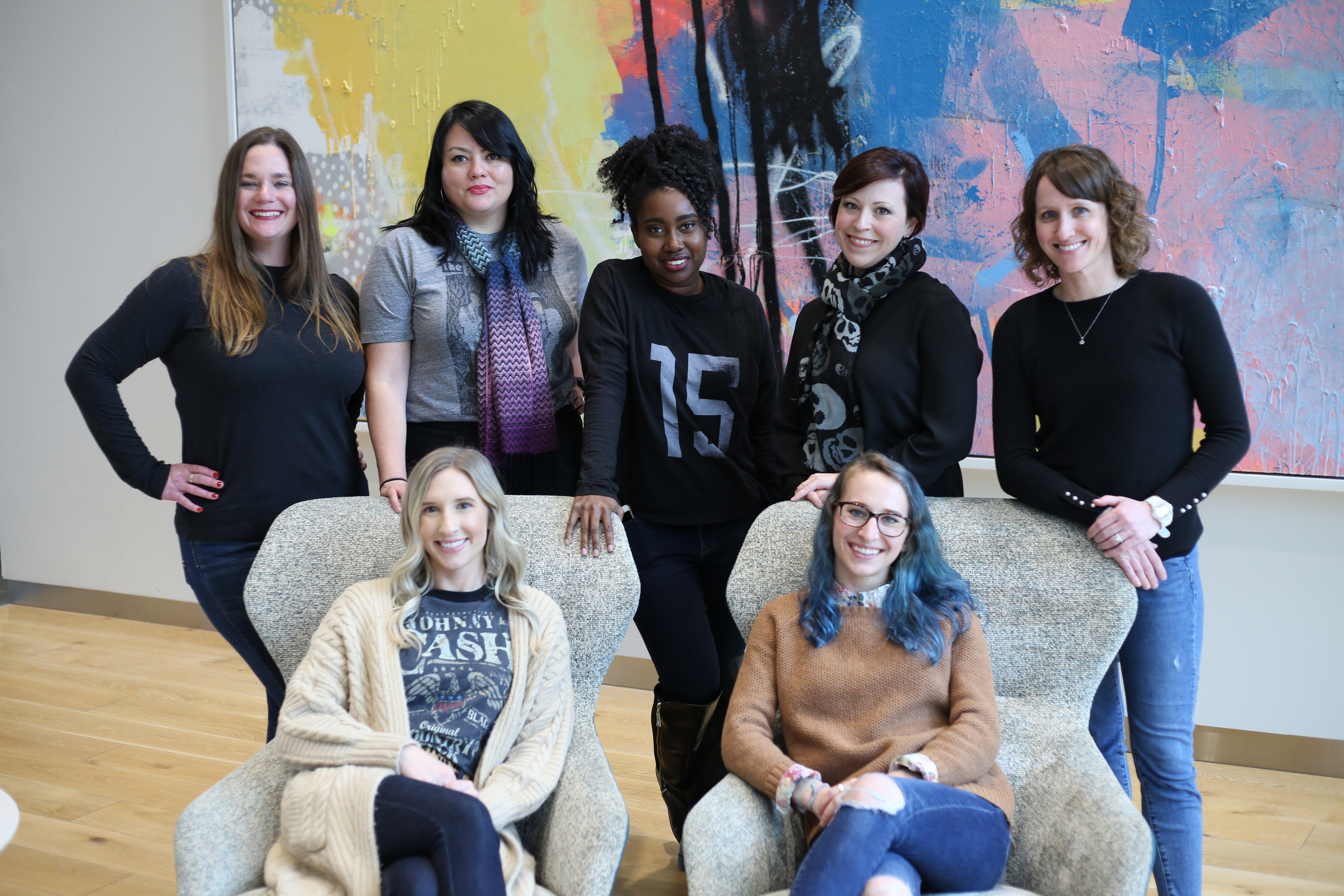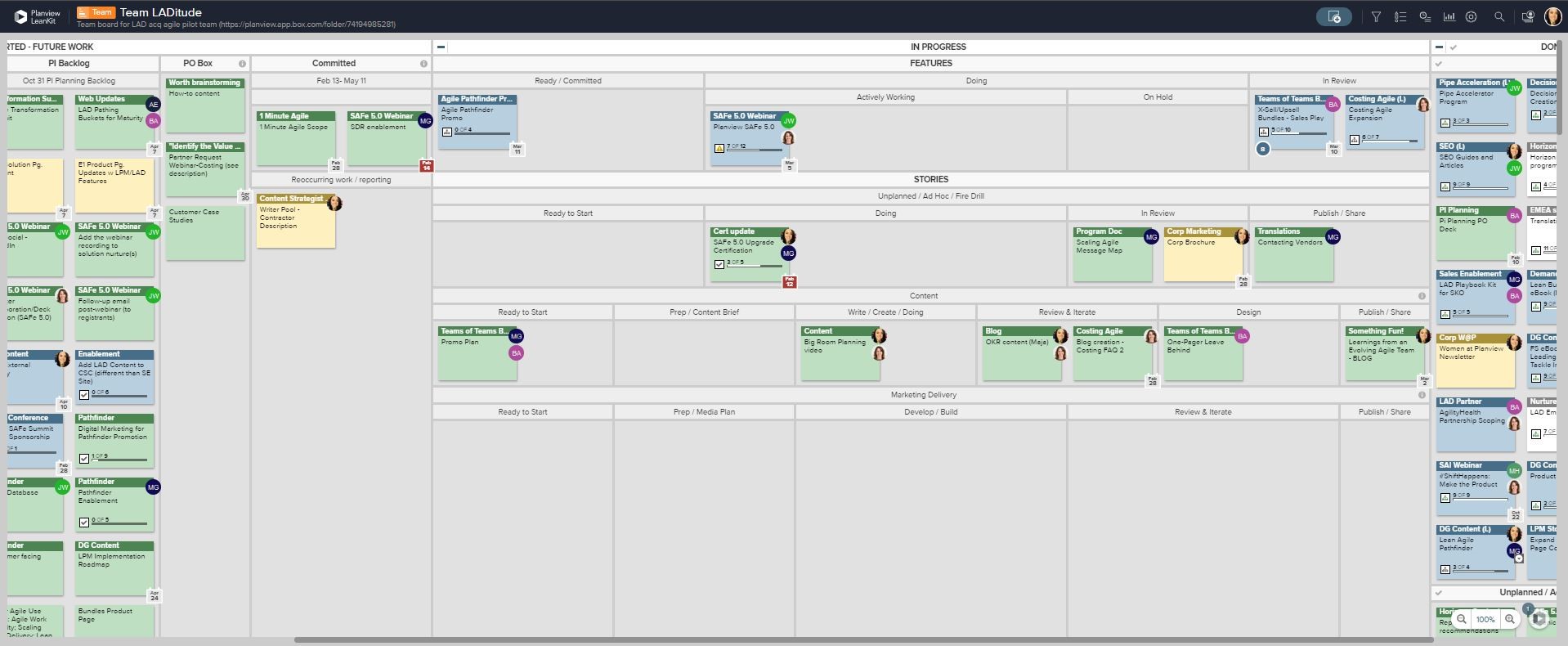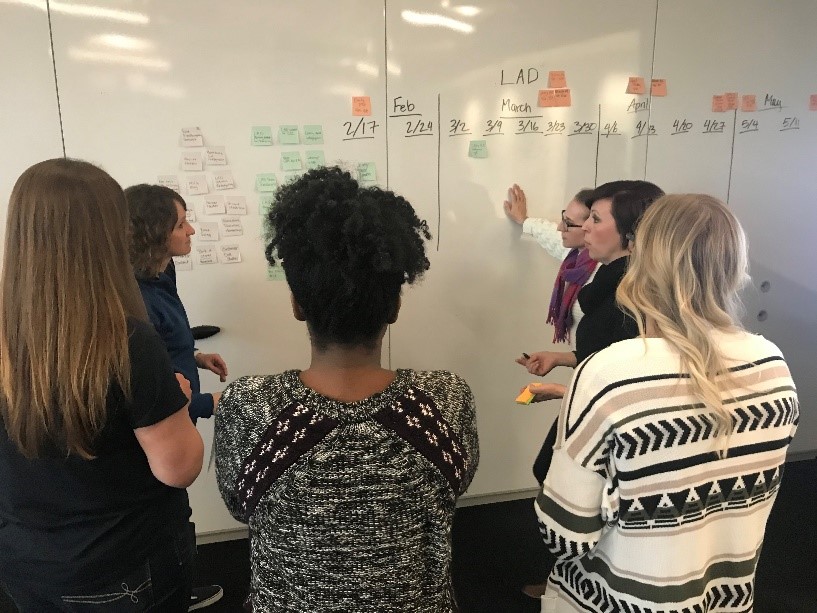
Like many organizations today, Planview has been on its own Agile transformation journey for more than a year now. As a seasoned member of the corporate marketing team and first-year Scrum Master, I’ve had the opportunity to see how “being Agile” has taken shape across the business and how adopting Agile principles has changed the way the teams approach work to deliver value. It’s been an extremely fun and rewarding learning experience, but we’ve also hit bumps in the road – which is absolutely expected with any type of transformation. As we move through the fourth program increment (PI), I asked several members of our team to reflect and consider how far we’ve come in our Agile transformation journey. Believe me when I say, change is not easy, but there is a lot to be said about the entire organization’s willingness to do things differently. But, before I get into the details of what has gone well and what has not, I want to introduce our team and share how the team is structured.
Check out a quick video of our product owner discuss lessons learned during PI Planning:
Team Structure
The Planview marketing organization is one release train, comprised of three go-to-market (GTM) teams. My team is famously referred to as LADitude (or what I like to call, Ladies with Attitude). We are the women behind the scenes who get it done. The sole purpose of the team to support everything related to the Planview Lean Agile Delivery solution. That encompasses creating market positioning, content strategy and development, building strategic demand generation campaigns, product launch planning, SEO, SEM, social media, blogging, sales enablement, events, and more – all with the aim to inform prospects, build PI pipeline, and ultimately sell more Planview software and services.
If you’ve ever worked in or with a marketing team, you’ve likely worked with demand generation or product marketing in some capacity, but perhaps not every day. The challenge? Traditional marketing approaches are often siloed – with the different departments focused on their area of expertise – and tap other domains of marketing as needed.
What is special about an Agile marketing approach is that you plan, work, and deliver value together across the various domains in marketing and the business, instead of in silos.
Our Agile marketing team is set up like this:
- Product owner: Product marketing director responsible for vision and overall direction
- Scrum master: Content marketing manager responsible for removing blocks and content strategy and execution
- Team members: Responsible for integrated marketing and value delivery in the areas of:
- Product marketing
- Product marketing and sales enablement
- Demand generation
- Sales development
- Content strategy
We also have “extended subject matter experts” that plan with each Agile marketing team to ensure initiatives are strategic, achievable, and support different areas of the business. Extended teams include members from executive management, digital marketing, international marketing, product management, sales, and consulting. The Agile marketing team and the extended teams plan together, share priorities, and make trade-off decisions about what will bring the most value to the business – which ultimately shapes our backlog.
Learnings from an Agile Marketing Team – Interviews
Agile marketing is a relatively a new way of working for the marketing domain in general. So, I asked the LADitude team members to share their experiences about what it has been like so that other marketers and Agile leaders might learn from both our wins and challenges.
Here’s what they had to say.
Product Owner, Brook Applebaum
Q: What are some challenges you’ve faced and overcome as Product Owner?
I think the biggest challenge is wearing multiple hats. I play the role of a Product Owner, director of product marketing, and individual contributor. When I started as the Product Owner for the team, I really struggled with balancing my time. I needed to stay aligned with executive leadership, attend those important business meetings, but still create messaging, positioning, and content from a product marketing perspective, as well as be a leader for two different teams – the Agile marketing team and the product marketing team. I neglected some of my duties as a product marketing leader, resulting in a frustrated team that felt like I was a roadblock. I learned that trust and empowerment is critical to success. Servant leadership is a key element of building a successful Agile culture, and I had to embrace it. I handed off some of my responsibilities to my very smart and capable team. This took some of the day to day responsibilities off my plate, enabling me to focus on more strategic and business critical issues. As a result, I think both the Agile marketing team and product marketing team are much happier.
Q: What Agile practices and/or principles does the team adopt to get work done?
A: We are a blended team of Scrum and Kanban, a Scrumban team. It’s hard to be pure Scrum as a marketing team because of the nature of our work. There are too many deliverables that roll over from sprint to sprint. We need some timeboxes to ensure we meet deadlines, but we also manage our process and flow in a visual to ensure smooth hand-offs and to create a culture of continuous improvement and learning.

Q: What is the biggest lesson learned to date?
The biggest lesson I’ve learned is that teams don’t get better unless they can discuss and talk through uncomfortable situations. If my team(s) had not told me I was a roadblock, their frustration would have continued. But because we embraced open communications and a culture of trust, we can grow together as a team – moving through forming to performing.
Q: What are some of the unexpected outcomes of an Agile marketing team?
A: We truly complement each other. The beauty of creating a cross-functional team is that each team member is cross-trained on different marketing disciplines without even realizing it. We’ve all become better marketers as a result of working together and being involved in the full process start to finish.
Product Demand Generation Manager, Jessica Woods
Q: What’s different about an Agile marketing team vs a traditional marketing team? What benefits have you experienced?
A: One of the major differences between Agile marketing and traditional marketing is that we plan and deliver work in two-week sprints. Even though traditional marketing teams share information across teams (i.e., AR, web, social, demand gen) on a regular cadence, they usually don’t plan and deliver in the context of a cross-functional team (sales, product marketing, product management). Additionally, after every sprint, the Agile marketing teams showcase the value delivered via marketing demos. Extended members across departments, domains, and geographies also consume this information and share and leverage it in their respective areas. Everyone has better view into what is happening across the business and can provide feedback for us to quickly consume and pivot, if needed.
As a bonus, we learn from each other. For example, my functional role is demand generation but within the Agile marketing team, I get to experience what product marketing or content marketing is working on, how they measure success, and get insight and know-how into their functional areas. I get more insight into what’s happening in the market, how it’s shifting, and how messaging is changing in response. By having this exposure, I can tailor the way we’re generating demand to better suit the type of engagements we’re looking for in the market.
When it’s all said and done, I’m getting exposure to parts of the business I wouldn’t necessarily have in a traditional setting.
Q: What is your favorite part about being on an Agile marketing team?
A: I like team backlog grooming. It gives us a chance to adjust the plan and optimize as we go – which I believe is at the heart of Agile.
Q: In the spirit of reflection and Agile retrospectives, what works, what didn’t, and what can improve?
A: We’re really good at collaborating and planning as a core team. We can work on improving how to incorporate our counterparts in different offices across the globe in our plans from the start. It’s challenging. We’re learning and improving as we go, but we can still get better at it. Being Agile helps you to plan in an integrated way, and we’re learning how properly size the work we commit to delivering.
Product Marketing Manager, Emily Peterson
Q: What’s different about being on an Agile marketing team vs a traditional marketing team?
A: One of the big differences is the Agile marketing team aligns to business outcomes, rather than functional goals, which keeps us better aligned with the rest of the business. In a traditional marketing organization, each silo would have its own goals or metrics. In an Agile marketing team, our goals align to the overall business (or sales) goals. If marketing is in the green (Leads and Marketing Qualified Leads), but sales pipeline is in the red, we can no longer say, “that’s your problem, not mine”. It’s our problem to solve together. In addition, we have line of sight, not just on what our team is doing, but on what other teams are doing, along with how sales is doing. We can work together better to solve for something bigger.
We also get to learn from each other. My functional role is Product Marketing, yes, but at the end of the day, I’m interested in learning more about how Marketo works and demand gen. In an Agile team, I can listen and observe these different “experts” on our team and learn from them, just as I hope they are learning from me.
Q: What are some of the challenges you’ve faced as a team member? How do Agile practices solve for some of these challenges?
A: Bottlenecks and handoffs – in a traditional marketing organization, there will be bottlenecks and handoffs. Sometimes, bottlenecks are because we don’t have enough people in a certain part of the business to handle what’s coming their way. Traditional marketing organizations also tend to follow a waterfall-like handoff process. You do your piece, then hand it to the next person, who hands it to the next person, and so on until it’s delivered.
For our team, Agile practices have helped solve a couple of things. One, it’s made visible where the bottlenecks are, and because we are all marching toward the same business outcomes, we can address those bottlenecks within the team and try to figure out a solution. We collectively want to do this better, so we collectively help each other out – let’s think about a tiered level of review. What can get reviewed without the PO and what must go through the PO because its core to our messaging and the strategy.
We’ve done a better job of cutting down on the handoffs. We still have to handoff work to those within our team that have the expertise but having visibility into all the work and communicating as we go has allowed other team members to pick things up in parallel. For example, we realized we had an opportunity to cut down on a handoff when creating and getting an asset into market. Rather than creating the asset and getting it to final stage before getting the backend work done to put it on our website and promote it elsewhere, we realized that as soon as that asset has a good, solid, close to final message, it could go to the rest of the team to review for feedback, but also to get started on other things, like social copy, landing page copy, content syndication blurbs, email nurture creation, etc. This cut our cycle time down considerably.
Q: What are some of the unexpected outcomes you’ve seen since being on an Agile marketing team?
A: A level of trust that allows us to have hard conversations. Over the last nine months, we’ve been delivering at breakneck speed. We had an opportunity to take a step back and do Emergentics. We all know we work differently, but when you take the time to look at how the brain works and how that translates to the work you do every day with a team of people, you realize you need to make some changes.
While some of our team members were primarily conceptual and social thinkers, others were analytical and structural. The hard conversations are those that must bridge these two different types of thinkers. We talked through how these two different profiles need different information to better do their jobs. While the conceptual and social thinkers were rolling along, thinking everything was peachy, those who were analytical and structural thinkers were having minor panic attacks trying to understand how the work they were doing, or the strategy we were implementing, was going to yield results or what our goals were for the strategy. Now that we’ve had this hard conversation, we’ve committed to building out the goals and desired outcomes before we commit to the work (i.e. new program, new asset). We also recognized people need time to process our plan after PI Planning. We committed to taking the week after PI Planning to do just this, and to then make space at the following team planning meeting to discuss the plan before truly committing to the work.

Q: What is your favorite part about being on an Agile team?
A: I love PI Planning. We’re getting better and better at this, and people’s voices are starting to really come forth. When a group of people has the opportunity to hear from executives what the most important things are for the business and can then take that information and build a plan for the next 10-12 weeks to build against is very fun. I also enjoy the fact that PI Planning gets everyone in the room, in a safe environment, to truly work through challenges and goals to come out on the other side with a plan that makes (some) sense.
Product Marketing Specialist with a focus on Sales Enablement, Meredithe Grigsby
Q: What are some of the challenges you’ve faced as a team member? How do Agile practices solve for some of these challenges?
I entered this role new to marketing and Agile practices and principles. The learning curve for both is fairly steep. I believe my learning speed was significantly accelerated by the wide variety of ever-changing work of our Agile marketing teams. It’s an added benefit that the subject matter of my work aligns with the practices and ceremonies we were implementing. With such an emphasis on collaboration and a willingness to embrace change, in no time I was contributing with confidence in the value I was adding (or that at least I have honest team members that would help redirect me if I was missing the mark).
Q: What are some of the unexpected outcomes?
A: At the end of each sprint and PI, I am amazed at the amount of work our team of six can accomplish. I’ve valued our regular stand ups as both a way to keep me accountable and on track with the work we’ve committed to, and to communicate bottlenecks and why work may be taking longer than expected. I also have a better understanding of how our business runs, as well as my contribution in the mix. Due to the cross-collaboration required of the team, I now know more people in my company in the first few months on the team, than I did during the first year that I worked here. I understand better the sheer amount of work required to keep our business running efficiently. Best of all, I have the pleasure of building a community here that makes coming into work fun.
Q: What is your favorite part about being on an Agile team?
A: Almost anything that involves getting the whole value stream together in the same room. The cross pollination of good ideas, templates, and silly, silly jokes that happens when the Agile marketing teams join forces is a marvel. We learn so much from each other and are constantly inspired by what the other teams have accomplished. There is a lot of cross over work within the release train, which prompts us to think not only how our work benefits our customers, but also our fellow Agile marketing teams. We are rooting for each other to be successful and helping one another get there.
Check out the YouTube Playlist: PI Planning at Planview for more videos.
Enterprise Kanban Enables Agile Transformation
Agile marketing is challenging, but there are also many benefits to transforming, including better visibility, improved communications across teams, more strategic integrated marketing plans, improved team morale, and improved value delivery. The tool that’s helped the LADitude team manage and visualize work is Planview AgilePlace. Planview AgilePlace connects all the features and stories and allows the business to go a step further, by rolling those features or deliverables to a program view (or board of boards), providing quick access to see the progress of committed work. In addition, as we mature, we’re starting to leverage the valuable reporting in Planview AgilePlace to size and set acceptable WIP limits to improve the flow of work. This information helps us plan effectively during a given PI and allows us to continuously improve our processes and flow of work.
No matter where you are on your Agile transformation journey, Planview understands that it can be challenging – we have firsthand experience. It takes time, patience, dedicated teams, servant leadership, and a positive attitude. If you are interested in taking Planview AgilePlace for a test drive, signup for a free trial. Stay tuned to the Planview blog for more about Planview’s Agile transformation journey.







